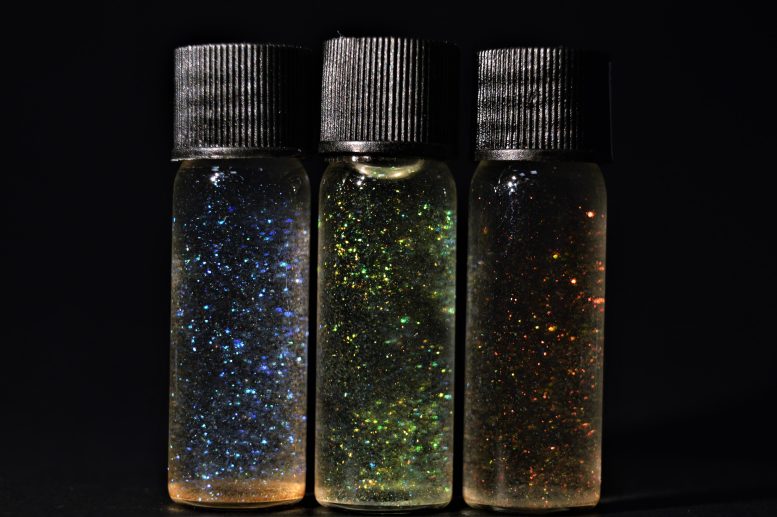
The photograph shows three vials containing an ensemble of photonic CNC particles dispersed in three different solvents: water, water: ethanol, and ethanol. The particles are the same in the three vials, the color difference between the three vials results from the ability of water to swell the structure of the particles. Higher water content means greater swelling of the cholesteric structures and a redshift of the color of the particles. Credit: Benjamin Droguet
Glitter is the bane of every parent and primary school teacher. But beyond its general annoyance factor, it’s also made of toxic and unsustainable materials, and contributes to plastic pollution.
Now, researchers from the University of Cambridge have found a way to make sustainable, non-toxic, vegan, and biodegradable glitter from cellulose – the main building block of cell walls in plants, fruits, and vegetables – and that’s just as sparkly as the original.
The glitter is made from cellulose nanocrystals, which can bend light in such a way to create vivid colors through a process called structural color. The same phenomenon produces some of the brightest colors in nature – such as those of butterfly wings and peacock feathers – and results in hues that do not fade, even after a century.
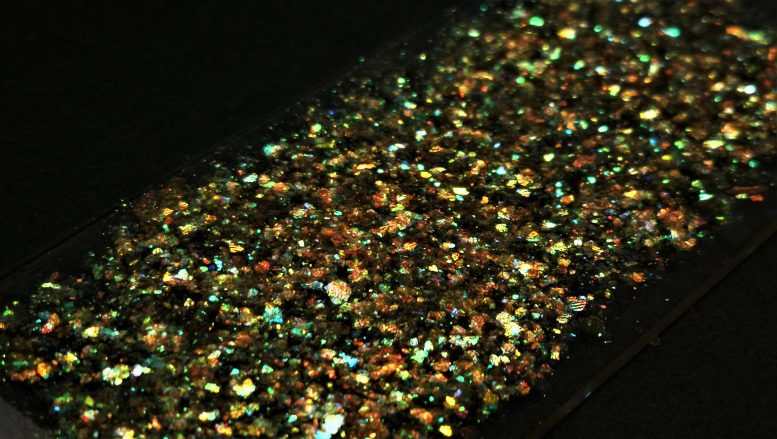
The photograph is a close-up of the glass slide that has been covered with gold flakes with high lighting contrast and observed at a larger angle. Credit: Benjamin Drouguet
Using self-assembly techniques that allow the cellulose to produce intensely-colored films, the researchers say their materials could be used to replace the plastic glitter particles and tiny mineral effect pigments which are widely used in cosmetics. In Europe, the cosmetics industry uses about 5,500 tonnes of microplastics every year.
The films of cellulose nanocrystals prepared by the team can be made at scale using roll-to-roll processes like those used to make paper from wood pulp, and this is the first time these materials have been fabricated at an industrial scale. The results are reported in the journal Nature Materials.
“Conventional pigments, like your everyday glitter, are not produced sustainably,” said Professor Silvia Vignolini from Cambridge’s Yusuf Hamied Department of Chemistry, the paper’s senior author. “They get into the soil, the ocean, and contribute to an overall level of pollution. Consumers are starting to realize that while glitters are fun, they also have real environmental harms.”
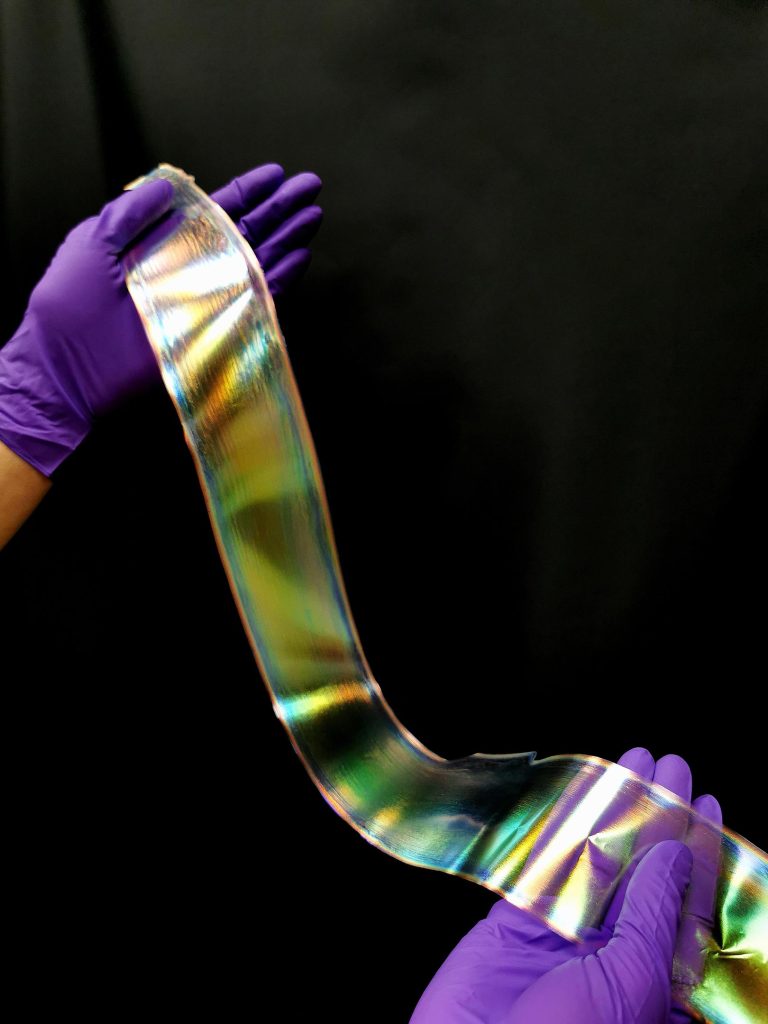
The photograph shows a film of cellulose nanocrystal that has been successfully peeled from its substrate, over a black background. Credit: Benjamin Drouguet
For many years, Vignolini’s research group has been extracting cellulose from wood pulp and transforming it into shiny, colorful materials, which could be used to replace toxic pigments used in numerous consumer products, such as paints and cosmetics.
“The challenge has been how to control conditions so that we can manage all the physical-chemical interactions simultaneously, from the nanoscale up to several meters, so that we can produce these materials at scale,” said first author Benjamin Droguet, also from the Department of Chemistry.
By carefully optimizing the cellulose solution and the coating parameters, the research team was able to fully control the self-assembly process, so that the material could be made on a roll-to-roll machine. Their process is compatible with existing industrial-scale machines. Using commercially available cellulose materials transformed into suitable liquid suspension in just a few steps, the team showed continuous deposition and drying of the cellulose-containing suspension on a commercial roll-to-roll machine.
After producing the large-scale cellulose films, the researchers ground them into particles of the size used for making glitters or effect pigments. The resulting particles are biodegradable, plastic-free and non-toxic. The demonstration of the fabrication process on a commercial equipment is an important step toward making the new material available outside the lab.
In addition, the process is far less energy-intensive than conventional methods. When they do not use synthetic polymers, companies often use mica and titanium dioxide combined into an effect pigment. However, titanium dioxide has recently been banned in the EU for food application due to its potential carcinogenic effects, while the extraction of mica often takes place in developing countries that may rely on exploitative practices, including child labor.
“Traditionally, effect pigment minerals have to be heated at temperatures as high as 800°C to form pigment particles. When you consider the quantity of mineral effect pigments that is produced worldwide, you realize that their use is harmful to the planet,” said Droguet.
“We believe this product could revolutionize the cosmetics industry by providing a fully sustainable, biodegradable, and vegan pigment and glitter,” said Vignolini.
Although further optimization of the process is still needed, the researchers are hoping to form a spin-out company to make their pigments and glitters commercially available in the coming years.
But will their glitter be as annoying as conventional glitter to anyone who’s ever done a craft project with small children?
“It will be just as annoying – but it won’t harm the planet and is safe for your little ones,” said Vignolini.
Reference: “Large-scale fabrication of structurally coloured cellulose nanocrystal films and effect pigments” by Benjamin E. Droguet, Hsin-Ling Liang, Bruno Frka-Petesic, Richard M. Parker, Michael F. L. De Volder, Jeremy J. Baumberg and Silvia Vignolini, 11 November 2021, Nature Materials.
DOI: 10.1038/s41563-021-01135-8
The research was funded in part by the European Research Council and the Engineering and Physical Sciences Research Council (EPSRC).



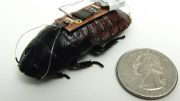



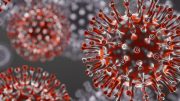

Be the first to comment on "Sustainable, Biodegradable, Vegan Glitter That’s Just As Sparkly – From Your Fruit Bowl"